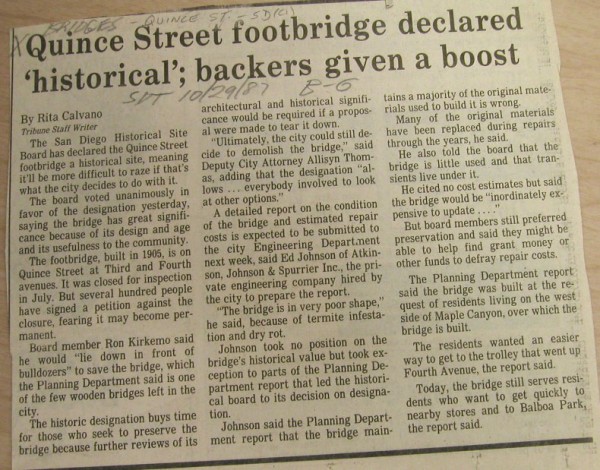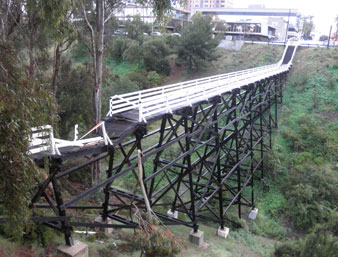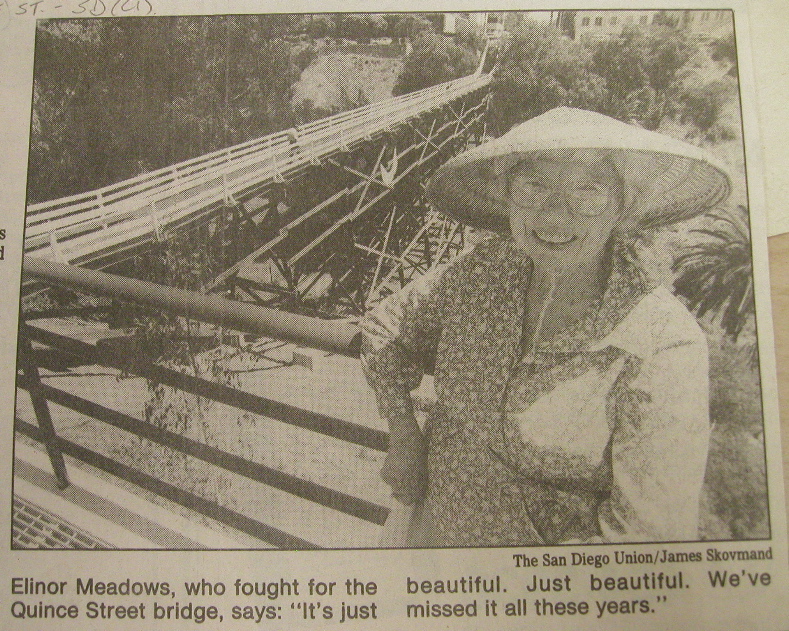Quince Street Bridge
- Built in 1905
- Construction cost was $805
- 236 feet long
- 60 feet tall
- Designed by city engineer (and Bankers Hill resident) George A. d’Hemecourt
- Spans Maple Canyon between Third and Fourth avenues
- Built to allow residents better access to the Fourth Avenue trolley line.
- One of few remaining wooden trestle pedestrian bridges in San Diego.
- Deck planks replaced in 1974
- Trestle bases reinforced in 1981
- Termites and dry rot forced its closure in 1987. Estimates for repairs exceed $100,000. The bridge was slated for demolition.
- Elinor Meadows lead local residents in a drive to obtain designation for the bridge as a city landmark.
- Bridge was restored with damaged timbers, beams and planks replaced by pressure-treated douglas fir. The project takes two years costing $250,000.
- The bridge reopened in August of 1990. Approximately 30% of the original wood remains.

In October of 1987,San Diego Historical Site Board voted unanimously to designate the Quince Street footbridge as an historic site.
Despite Emotional Attachments, Future Bleak for Quince Street Bridge
Los Angeles Times, November 28, 1987
“Can you feel what a wonderful feeling it is?” asks Elinor Meadows, perched in the middle of the simple wooden bridge, facing the distant bay, below her the canyon brimming with blooming cactus, rippling palms and ascending bamboo. “Can you see how important this is?”
For more than half a century, the Quince Street Pedestrian Bridge has served as both a medium of transportation and an aesthetic retreat for residents of Hillcrest and other walkers, particularly those destined for and returning to nearby Balboa Park. The wooden trestle structure has long afforded a popular stroll for lovers, groups, solitary pedestrians and others not inclined to drive.
For many, the bridge is a lovable anachronism in an era when fast cars, freeways and airplanes have redefined the character of travel. The bridge, its advocates say, represents a throwback to a time when a simple walk was itself an experience to be savored, not a motor-less inconvenience. More than an artery connecting Third and Fourth avenues, they say, the bridge is a rare bastion of civility amid the urban bustle, an amenity of particular importance to the area’s many elderly and disabled residents.
Pressures of Time
Now, Meadows and others fear, the bridge itself-one of the city’s oldest-may be succumbing to the pressures of time.
Four months ago, city officials shut down the bridge without notice, saying that a routine inspection had shown it to be infested with termites, full of rotting wood and generally unsafe. “It’s in bad shape,” said Jim Casey, director of the city’s Department of Engineering and Development.
The bridge, he noted, is not heavily traveled; a recent survey found only 57 people using it on a Friday.
The bridge faces a cloudy future. A city-hired consultant recently evaluated the structure; a report based on that examination will be forwarded to the City Council in coming weeks.
The report’s “primary recommendation,” said Dave Zull, a senior civil engineer with the city, was that the bridge simply be torn down and not replaced. The consultant estimated that it would cost up to $100,000 to repair the structure, Zull said. (This, for a bridge that cost $850 to build in 1905.) The secondary recommendation, Zull said, was to tear down the old bridge and replace it with a modern structure, which would cost about $150,000.
Thus, the bridge’s ultimate fate will be placed in the hands of the City Council. Looming in the future is a prospective battle between practicality and aesthetics, between the cost of repairing a relatively little-used bridge and the potential loss of one of the city’s dwindling number of contemplative perches.
Torn Down in 1980
There is fear that the Quince Street structure could meet the same end as the Vermont Street bridge, which spanned Washington Street in Hillcrest and led to the former site of the Sears store; despite city pledges that it would be maintained into the next century, the dilapidated bridge was torn down in 1980 and never replaced.
“It was in terrible shape,” noted Casey, the city engineer.
At the other extreme, there is the case of the 65-year-old Spruce Street Suspension Bridge, also in the Hillcrest area, just a few blocks from the Quince Street structure. Last year, the city refurbished the charming, swaying Spruce Street bridge at a cost of $315,000. But that bridge possesses the distinct design advantage of having steel cable and steel supporting elements, meaning that it can be expected to last for a long time with relatively little maintenance. The Quince Street span is predominantly wood, which is more prone to damage from weather and other factors.
Even before the battle lines are drawn, Elinor Meadows is doing her best to get the word out about the threatened bridge from her comfortably cluttered Third Avenue home, which is situated at the edge of lush Maple Canyon, practically in the bridge’s shadow. From her enclosed sun porch, the Quince Street span looms like an ethereal structure in a Japanese print, its eastern terminus shrouded in pepper trees. At night she feeds some of the creatures [opossums, skunks and a solitary raccoon] who reside in the canyon; a family of gray foxes fled a decade ago.
“I enjoy watching the bridge, watching the people crossing,” says Meadows, a native San Diegan, who, along with her husband, Rush, has lived in the same home for 36 years.
Despite her 73 years, Meadows easily climbs the barricades blocking the bridge’s entrance, eager to show the structure to a visitor. While not faulting the city for closing the bridge if it was deemed unsafe, she maintains that it should be repaired and reopened as soon as possible.
“You’d be surprised by this old bridge,” says Meadows, a retired art teacher who bears a resemblance to Eleanor Roosevelt, “so many people care about it.”
Indeed, beyond simply signing their names to a petition, many bridge advocates have been moved to express their feelings on paper provided by Meadows.
“Does everything have to serve the auto?” asked one man.
Noted another walker, “This little pocket (this canyon) of old California is one of the most wonderful spots in San Diego.”
From a pair of visitors from Scottsdale, Arizona, “We found this spot while walking and would like to come back every year. It’s wonderful! This must be California as it was before we all ruined it.”
Strong Memories
For others, the bridge has inspired strong memories. Meadows received a telephone call from one woman who was aghast at the notion that the bridge might be shut down.
“They can’t close that bridge!” the woman said. “That’s where my father proposed to my mother.”
On the bridge, too, visitors are apt to leave their mark, perhaps moved to the introspective by the tranquil setting. “I Never Can Forget Her,” someone has written on the wooden banister, “But Goodness How I Try.”
While the present-day bridge may inspire some to flights of fancy, that was not its original intention. Practicality built the bridge. The structure was constructed in 1905 at the requests of residents who wanted betteraccess to the trolley line that ran on Fourth Avenue. It was designed by George A. D’Hemecourt, then the city engineer.
Since then, the bridge’s basic look has varied little, although it has undergone extensive renovation; the deck planks were replaced in 1974 and the trestle bases were reinforced with concrete in 1981. The bridge is 236 feet long, six feet wide and 60 feet tall at its highest point.
To dramatize the bridge’s plight, Meadows recently strung paper tears from the structure. Meadows also placed a hand-written sign alongside the span’s entrance, written from the bridge’s point of view.
“I am an old bridge,” the sign said. “I was the pioneer structure across a lovely canyon. I have carried my share of walkers. I have provided a place to view the bay, a quiet place to pause, to stop and think. I have seen many changes. The bay is busy, the air is heavy, the streets are crowded. My people need me more than ever. But where are they? No one crosses me now. It’s enough to make an old bridge weep.”
Next to the handwritten posting was a more prosaic sign, which still remains. “Bridge Closed,” it reads, “Until Further Notice.”

On Sunday, March 20, the west side of the footbridge was damaged by a branch of a fallen tree.
Thanks to everyone for emailing Councilman Kevin Faulconer asking to get it opened again as soon as possible.


